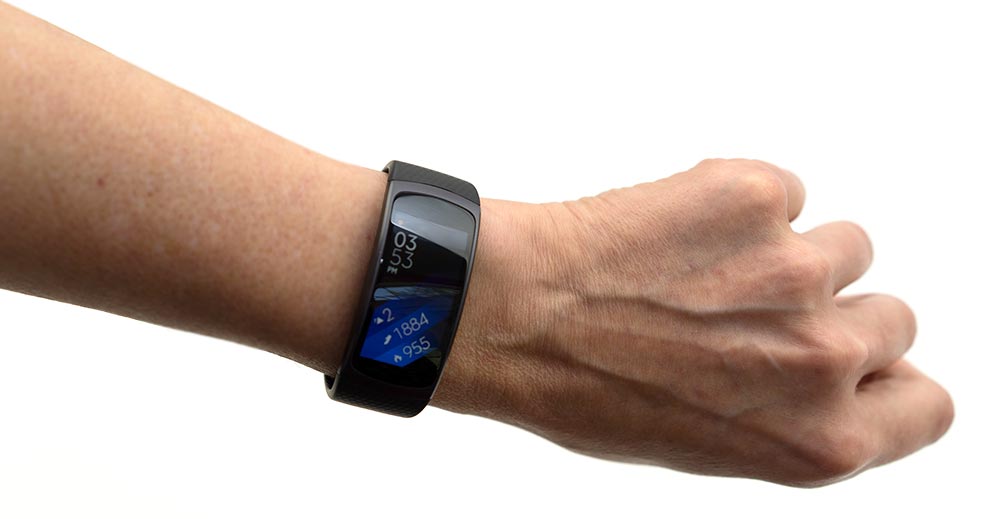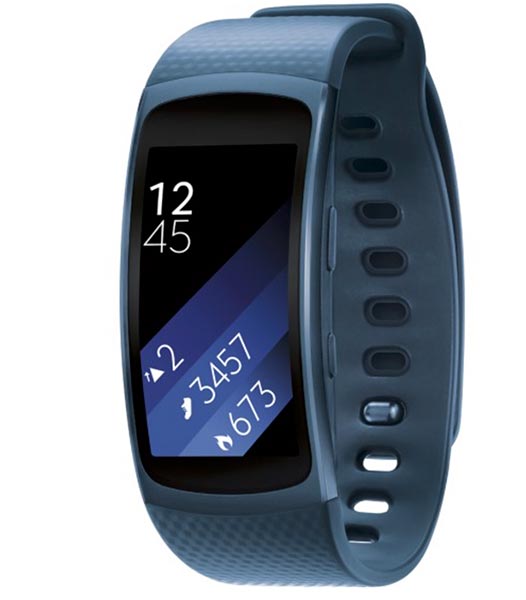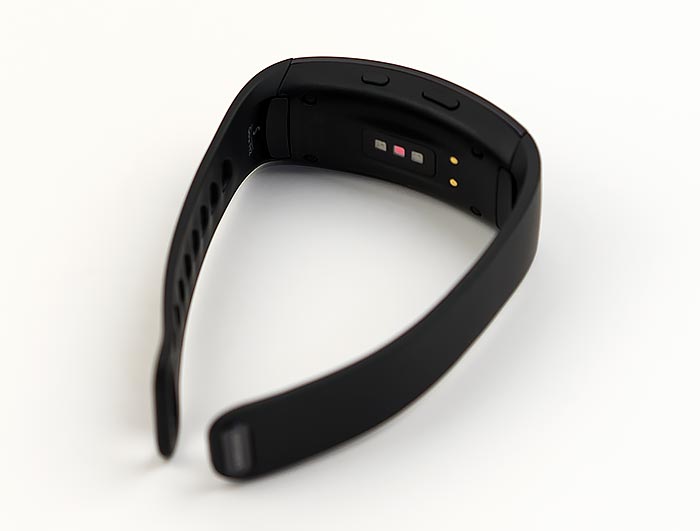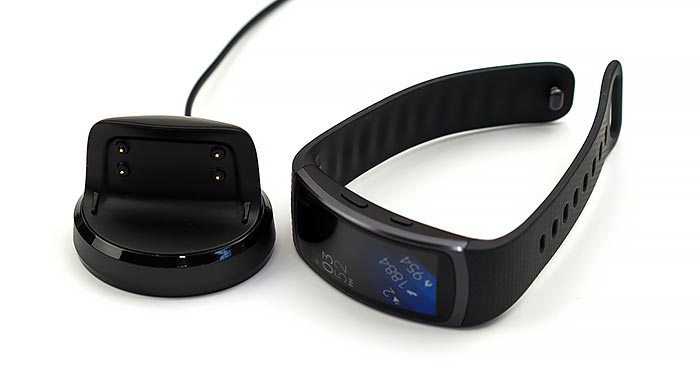
|
|
|||||||
|
Home > Gadget Reviews > Samsung Gear Fit 2
Samsung Gear Fit 2
What's Hot: Sleek looking, very comfy, lovely curved AMOLED display, decent battery life. What's Not: App selection is small right now. As with all optical heart rate monitors, it gets confused by certain activities.
Reviewed June 28, 2016 by Lisa Gade, Editor in Chief (twitter: @lisagade)
|
|||||
|
The Samsung Gear Fit 2 is a little bit Tizen OS smartwatch and a big heaping of fitness band. Like the original 2014 Gear Fit, it has a lovely curved AMOLED display that's comfy on the wrist, but most everything else has been upgraded or tweaked. It has more storage--4 gigs to hold music and apps, a wider and shorter display and a faster CPU. The Gear Fit 2 works with any Android phone running OS 4.4 or newer, but it doesn't support iOS. It's available in two sizes and three colors: black, pink (dusky rose rather than neon pink) and blue (what I'd call cornflower blue). It has a textured elastomer hypoallergenic band that's softer and suppler than the original Fit's, and it's soft to the touch and very comfy. The Fit 2 is relatively light in weight and I barely notice it on my arm (most smartwatches and fitness bands feel heavy and dig into my bony wrists, so I'm picky). The Gear Fit 2 is aggressively priced at $179, making it much cheaper than the Apple Watch and significantly cheaper than Microsoft Band 2 (though MS's second gen band has recently been on sale for $175) or the Garmin Vivosmart HR+. The Gear Fit 2 is a modern and good looking device. It lacks the brushed aluminum housing of MS Band 2, but that's OK with me since it's also considerably lighter and less bulky. The band is strong and the clasp mechanism is fairly easy to operate. If you wear the band loosely enough that it might catch on things, beware that the clasp (more like a pin and hole system) can come undone. This hasn't happened to me, but some other folks have mentioned it. I do wear mine fitted close to my wrist. Should you wish to change the band, you can do so, and it's fairly straightforward since there are no sensors or battery in the band. The 1.5" AMOLED display catches the eye with vivid and bright colors. Its 432 x 216 resolution works out to a very good 322 PPI. The screen is protected with Gorilla Glass 3, and it's survived a few hard contacts with door jambs unscathed (my Apple Watch Sport's display had scratches after 2 weeks given my habit of swinging my wrists wide). The device has two buttons: home and back. Pressing the home button will wake the display just in case the usual lift your wrist to look at the time gesture didn't work (it does work most of the time). You can enable an always on display that shows the time; it's faint and monochrome to save battery.
The UI is intuitive and friendly, which is refreshing compared to many dedicated fitness trackers on the market. It's easier to use than the Apple Watch as well, and much more intuitive than the sometimes opaque Microsoft Band 2. You'll use swipes to switch between notifications, various fitness activities and settings. A swipe down on the home screen shows the battery level, connection status and grants access to the music player. A swipe to the right shows notifications piped from your phone (an orange dot on the home screen tells you when there are notifications). Swipe left to get to the exercise activity apps, step counter log, heart rate, calorie counter and settings screen. The display operates only in portrait orientation, which is fine by me because horizontal mode would require awkward arm and wrist acrobatics. Two companion apps, Gear and S Health on the phone, let you manage the fitness band and track your exercise history. You'll use the Gear app to install new apps, of which there are few right now since the device is new. The most interesting are an alarm clock, stop watch, additional watch faces and Spotify (Spotify streams tunes from your phone, so the fitness band is merely a remote control). S Health grants granular access to your exercise activities, heart rate data and more. If you happen to own a late model Samsung Galaxy S series phone, you can also use S Health to check your blood oxygen level and record that data. S Health is cleanly laid out and easy to understand, the only thing I didn't like were the annoying ad-like tips at the top to try out different features and read health related articles (you can dismiss these, but it will come up with a new one every day).
Smart watch apps are limited right now, with the music player being the hottest item--you can store up to 1,000 songs on the watch and play them via Bluetooth headphones connected to the Gear Fit 2, so you needn't take your phone with you to listen to tunes while you exercise. Notifications are piped from the phone to the Gear Fit 2, and you can deselect those you don't wish to see on the watch. These include texts, phone calls, and anything in your Android notification queue like weather, news and sports, and email. You can't respond using the Gear Fit 2, nor can you carry on phone calls using the fitness band, but you can read a decent amount of text on screen without resorting to the phone. If you're using Samsung's messaging app rather than the stock Android SMS message app, you can send canned short responses and emoticons using the band. The Gear Fit 2 communicates via Bluetooth and WiFi Direct to extend range. If you wish to put music on your Fit 2, you'll transfer songs via WiFi Direct from the phone to the Fit 2 (the Gear doesn't interface with PCs). The band will vibrate to let you know if it's lost or regained connection to the phone. It doesn't have a speaker, so you won't get auditory alerts, though there is free downloadable alarm clock that will attempt to vibrate you awake (it works for me, but I'm a light sleeper). |
Deals and Shopping:
Advertisement |
||||
|
Samsung Gear Fit 2 Video Review
Exercise Tracking The Samsung Gear Fit 2 has a GPS, step counter, heart rate monitor and barometer to calculate stairs climbed (changes in elevation). It's IP68 water resistant so you can sweat on it and run in the rain, but if you shower with it or wash it, the barometer may get confused for a day or two, throwing off your stair count. It's not designed to work for swimming workouts. It supports a wide variety of exercises including outdoor and stationary biking, running, hiking, rowing machine, weight lifting, yoga, elliptical and Stairmaster. The heart rate monitor is accurate for running and biking but it apparently isn't activiated when using the rowing and weight machines (perhaps because it would be inaccurate). When you start an exercise session on the band, it will show duration and your heart rate (if supported). I actually prefer that it not try to show my heart rate if the results will likely be wrong. For example, the Apple Watch shows erratic and obviously wrong heart rate data (from wildly low to crazy high) and the MS Band 2 showed much too high a value (though it claimed to have locked onto my heart rate) when using the rowing machine. Overall, the heart rate monitor is decently accurate for an optical sensor when running, hiking and biking, and it worked perfectly when going about daily business. It checks your pulse every 10 minutes when not exercising and continuously when exercising, and records that data for viewing in S Health. |
Advertisement |
The Gear Fit 2 also has a sleep monitor, and I found it comfortable enough to wear when sleeping. Less thrilling is that the band's display woke up when I turned over, so I had to set brightness low before bed. The sleep tracker, like most, isn't terribly useful beyond tracking hours in bed. It was fooled when I got up in the night to use the bathroom at 4am one night but it wasn't fooled on other nights when I had to hit the bathroom in the middle of the night. The night my nocturnal bathroom visit confused it (too much watermelon plus a beer before bed), it thought I slept only 5 hours, because it somehow failed to notice I went back to bed and slept another 3 hours. That night it said I slept with 96% efficiency, while on other nights of continuous 8 hours sleep without bathroom interruptions, it had no opinion of my sleep quality. You don't have to tell the band that you've gone to bed; it figures that out automatically. In case you forget to tell it that you've started a run or bike ride, it will figure that out too, though it may take it a few minutes to notice and start recording the exercise event. Typical of fitness bands, the GPS can take a few minutes to lock on and record your route. S Health can provide a map of your route once you're done, which is a nice touch. I found it accurate in terms of route mapping and distance covered.
Battery Life Samsung claims 3-4 days from the 200 mAh battery. I averaged 2.5 to 3 days, which is better than most smartwatches but falls short of dedicated fitness trackers. The big and bright AMOLED display and smartwatch style notifications simply consume more power compared to a fitness tracking wearable. Long and frequent exercise sessions affect battery life since the heart rate monitor is constantly on when exercising, though I found it drained less during exercise than the Apple Watch. The Gear Fit 2 ships with a compact charging station, cable and charger (the same 5v 2 amp charger supplied with older Samsung phones). I used my Galaxy S7 charger and the supplied cradle + cable and it worked fine so there's no need to take two chargers on the road.
Conclusion The Samsung Gear Fit 2 pleasantly surprised me: it's a good combination of smartwatch notification features and fitness tracker for the beginner to moderate exercise fanatic. The band's interface is intuitive and the Gear and S Health apps are easy to use and great for tracking a variety of exercise types and heart rate metrics. The Gear Fit 2 is comfortable and durable, and the display is bright and colorful and I had no trouble seeing it outdoors. If you're looking for that blend of smartwatch style notifications and moderately advanced fitness tracking with a friendly interface, the Samsung Gear Fit 2 is worth a serious look. That is, if you own an Android phone since that's the only supported mobile OS. Price: $179 Website: www.samsung.com Related Reviews: |
|




